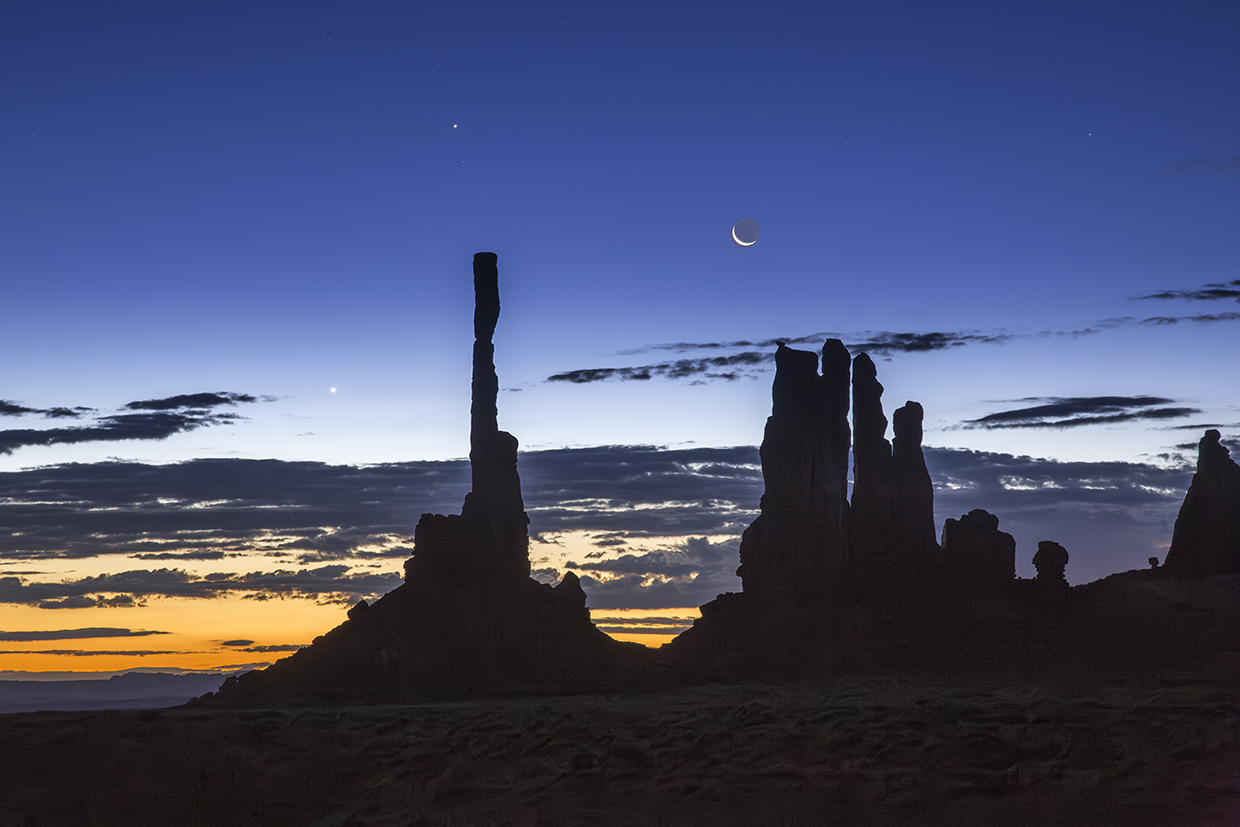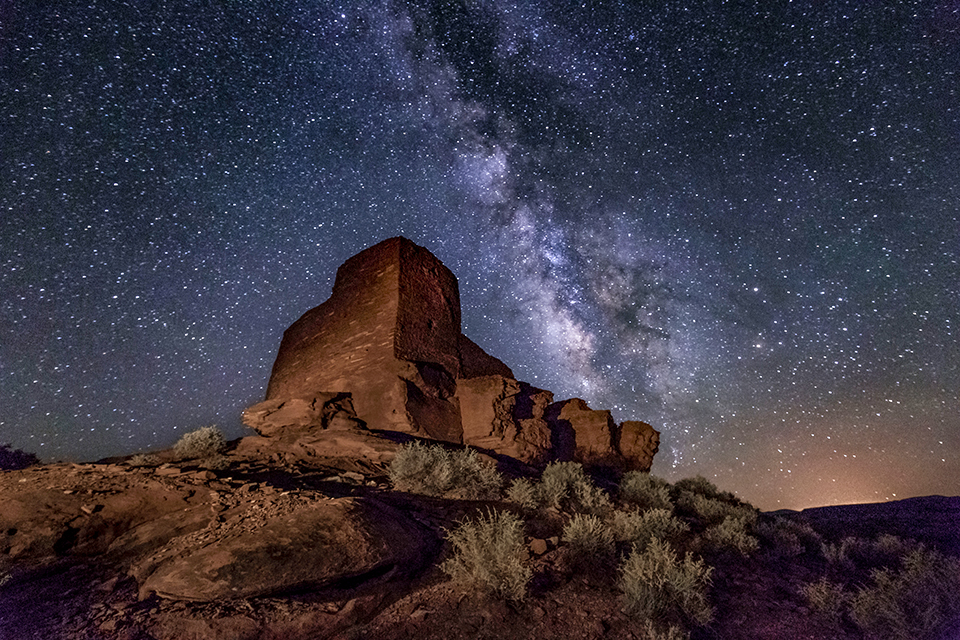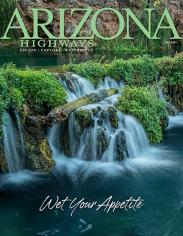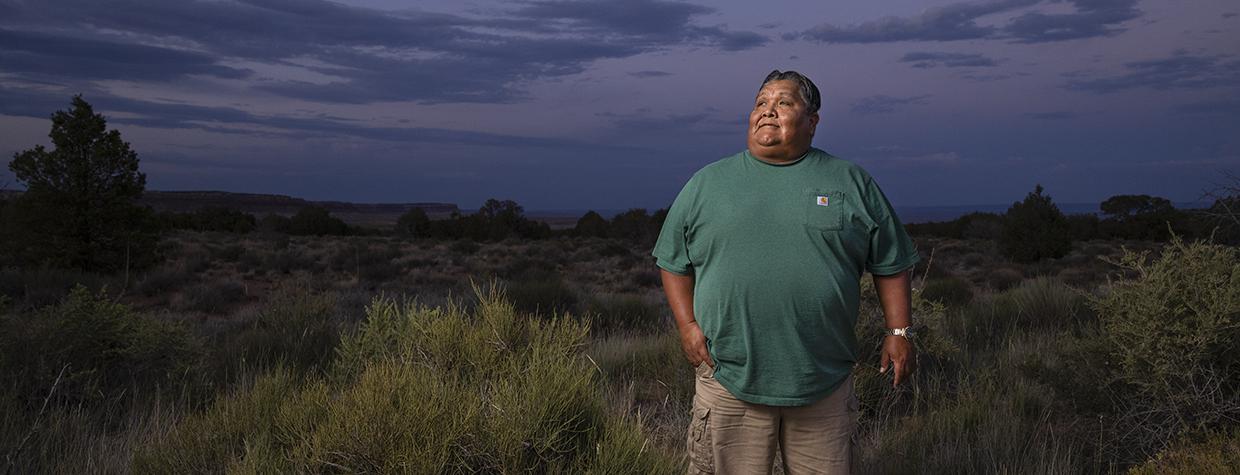When members of the Kaibab-Paiute Tribe look up at the night sky above their homeland in one of the darkest places in the Lower 48, a bighorn sheep named Naag often comes to mind.
According to a traditional Paiute story passed down for countless generations, Naag was the son of the creator. The bighorn, exceptionally courageous and confident, had a knack for climbing the tallest cliffs to find the best grazing sites. But one day, Naag climbed too high and was trapped. The creator took pity on his favorite son and tossed Naag high into the sky. The bighorn became the North Star and would serve as a guiding light for humans on Earth.
Sitting in the middle of the Kaibab-Paiute Tribe’s public campground, I spot Naag not long after the sun drops behind rust-hued cliffs. The star commands its predictable position in the northern sky, which has turned a deep indigo. Called Polaris in Western astronomy, the North Star is a stellar touchstone for humans everywhere, but despite being anchored to its place in the sky, it often is not visible to those in urban areas. As outdoor lighting in our electricity-driven world has grown exponentially over the last century, the possibility of an unobstructed view of the stars, and feeling connected to the cosmos, has dimmed to near nonexistence.
The Kaibab-Paiute homeland is the rare exception. The tribe’s 120,840 acres occupy a remote stretch of high desert on the Arizona Strip, about 50 miles north of the Grand Canyon and just south of the Utah state line. It’s surrounded by millions of acres of protected public lands, with sprawling Baaj Nwaavjo I’tah Kukveni-Ancestral Footprints of the Grand Canyon National Monument to the south, Vermilion Cliffs National Monument to the east, Utah’s Grand Staircase-Escalante National Monument and Zion National Park to the north, and Grand Canyon-Parashant National Monument to the west. The campground, along with the tribe’s residential community of approximately 300, is an island of civilization in the middle of a sea of uninterrupted space.
Once the sky darkens above my star-watching perch, I settle into my camp chair as if I’m in an IMAX theater. I have a thermos of hot tea in one hand and a fistful of chocolate-covered almonds in the other. The big screen is overhead and all around, with stars and planets popping out from horizon to horizon. Jupiter is big and bright, dominating the western sky. Mars radiates reddish-yellow overhead. Star clusters sparkle like diamonds and are surrounded by countless pinpricks of white that blanket the inky darkness so thoroughly that it seems the sky is more light than dark.
The Kaibab-Paiute Tribe’s land was designated a Dark Sky Community in 2015 by DarkSky International, cementing its stellar reputation for star watching. According to the nonprofit conservation organization, the Arizona tribe is the world’s first “dark sky nation.”
I had long heard about the unmatched star viewing on the Kaibab-Paiute homeland and finally embarked on a solo camping trip to see the legendary night sky for myself. I strategically timed my visit for a night in late March when the sky was clear and absent of moonlight. My planning has paid off: For several blissful hours, I sip my hot tea beneath the heavens after a half-dozen campers in RVs have seemingly gone to bed.
But as two cars come barreling up the campground’s gravel road with high-beam headlights blazing, I realize my star-watching strategy overlooked one important detail: It’s spring break for many college students.

Much to my disappointment, the students decide to be my neighbors in the largely empty campground. They park about 100 feet away, and seven or eight young adults spill out of the vehicles. Donning headlamps and swinging high-powered flashlights, they stumble around, piercing the darkness, as they assemble their tents and attempt to make dinner. I could complain to the campground host, but that would be hypocritical — I once was a college student who, more than a few times, straggled into a campground with my friends after sundown.
Despite the commotion of my rowdy neighbors, I keep my eyes trained on the sky. The unfathomable enormity of the universe has a way of shrinking nagging discomforts on Earth down to size. Directly overhead is the closely spaced cluster of stars that Greek astronomers named the Pleiades. The Paiutes, though, call the constellation Sonee. Like Indigenous communities everywhere, the Paiutes have their own names for constellations, as well as stories about the cosmos that are an important part of their culture.
Traditional practitioners have opened my eyes to a more expansive concept of the night sky — a state of mind I seek to embrace from my campsite beneath the heavens. The stars are awe-inspiring, and studying the cosmos holds great scientific value. But there’s something more. According to many Indigenous cultures, the seemingly distant cosmos is also intimately connected to life here on Earth. And the stars have something to tell us — if we turn off the lights and listen.
The Kaibab-Paiute Tribe is one of 10 bands among the Southern Paiute people, whose historical homeland spreads across present-day Northwestern Arizona and neighboring parts of Utah, Nevada and California. According to Kaibab-Paiute Cultural Resource Director Daniel Bulletts, there were dozens of Paiute bands before European immigrants arrived in the area, with each band numbering 500 to 5,000 members. The semi-nomadic bands traveled to seasonal camps and grew crops. They depended on the stars for nighttime navigation and knowing when to start planting.
The heavens were a source of spiritual sustenance, too. “Night was a time of quiet and reflection,” Bulletts says. “When we were looking up at the stars, that is when the stories and teachings were shared.”
Bulletts says the Southern Paiutes were decimated by disease and “mass killings” during the 19th century period of colonization. By 1900, the Southern Paiute population had dwindled to approximately 800; then, like all tribes in the U.S., the Paiutes saw their children and their children’s descendants sent to residential boarding schools, where the goal was to remove connections to their Indigenous culture — including stories about the stars. Traditional practices were dismissed as pagan rituals, and tribal teachings about astronomy went dormant along with Indigenous languages, songs and stories.
While Western science relies on mechanical devices such as telescopes for precise observations of celestial objects, the naked eye astronomy by North America’s ancient Indigenous peoples was also highly sophisticated. Chaco Canyon, Hovenweep and Wupatki national monuments all contain structures that accurately measure celestial events such as the summer solstice and spring equinox. And ancient petroglyph panels left by Paiute ancestors chronicle the passing of comets, moon phases and constellations.
In those and other ways, Native people were North America’s first scientists. But unlike the Western approach to science, which is based on compartmentalizing things, Indigenous science is rooted in the concept of interconnectedness — and that includes a link between humans and the cosmos. This vital relationship, though, is interrupted if the stars are obscured by light pollution.
Even though the Kaibab-Paiute Tribe boasts one of the darkest skies in the Southwest, it’s not as dark as what the Southern Paiutes would have observed above their homeland several centuries ago. In recent decades, the glow of Las Vegas has become visible on the western horizon some 200 miles away, as have the lights of St. George, Utah, about 70 miles away.
Like the Southern Paiutes, the Western Apaches were semi-nomadic before European colonizers arrived in their homeland spanning present-day Arizona and New Mexico. They relied heavily on the stars for navigation, as well as for infusing their culture with stories and spiritual connections to the creator.
“Each of the star groups or constellations has guided the Apache people both physically and spiritually,” says Bob Stevens, a traditional practitioner who is a member of the San Carlos Apache Tribe and supervisor of the tribe’s Language Preservation Program. “The stars give us wisdom. We believe that the stars whisper to us and help guide us through life.”
Stevens says an important trait of Apache leaders in pre-contact times was the ability to read the constellations for navigation and seasonal changes, as well as to “understand the relationship” with the sky. “Spending time under the stars was how the leaders gained their wisdom,” he adds. “It was how they received knowledge about the path they should take for their people.”
However, as Arizona’s population has grown — especially in the Phoenix metro area — Stevens has found it harder to maintain the spiritual connection to the cosmos that his ancestors once experienced. “No matter where I am, I always notice light coming from someplace, unless I am in a deep canyon,” says Stevens, who is an avid hunter and hikes across remote stretches of the San Carlos Apache Tribe’s land in Eastern Arizona.
According to a January 2023 article in Scientific American, a National Science Foundation study found that light pollution in the United States increased by an average of 10 percent every year from 2011 to 2022. The data showed that the nighttime glow across much of America is doubling in brightness every seven to eight years.
“When I am sitting on top of a mountain beneath dark skies, the stars are there, but I also see the glow on the horizon,” Stevens says. “It upsets my concentration and overtakes my mind. The path for receiving messages from the stars about things I want to know is interrupted.”
For Stevens and other Native traditional practitioners interviewed for this story, maintaining a relationship with the cosmos is not just about communicating with the stars in a dark sky. It also requires showing respect for everything in the universe and not interfering with the cosmic environment — which includes Earth’s closest neighbor.
In December 2023, the Navajo Nation government became alarmed when it learned several new commercial enterprises planned to send cremated human remains to the moon. According to one company’s website, a $13,000 fee buys a spot on a rocket that will carry a capsule containing a deceased person’s ashes. The remains are deposited on the moon by a lunar lander or launched into outer space to drift forever through the universe.
“The sacredness of the moon is deeply embedded in the spirituality and heritage of many Indigenous cultures, including our own,” wrote Navajo Nation President Buu Nygren in a January 2024 public statement objecting to the practice. “The placement of human remains on the moon is a profound desecration of this celestial body revered by our people.”

Nygren’s request that Indigenous spiritual beliefs about the moon be respected was ignored by companies offering the “memorial spaceflight” service, and a rocket carrying the remains of 70 people was launched in January 2024. But the spacecraft experienced mechanical failure and, instead of reaching the lunar surface, burned up re-entering the Earth’s atmosphere. A second attempt is planned for late 2025.
Navajo activist Janeen Phillips has created a public outreach organization to raise awareness among non-Natives about Indigenous perspectives on protecting the moon — and the rest of outer space. Called the Níhookaa Diyin (Holy Earth Dwellers) Diné Protectors Organization, the group is a coalition of Navajo traditional practitioners and university faculty members focused on science and technology.
“We are trashing outer space with junk,” Phillips says of how NASA and private companies abandon spent rocket boosters and decommissioned satellites, allowing the objects to litter the Earth’s orbit like tossed soft drink cups along freeways. She’s also concerned about the lunar memorial business and proposals by various countries to mine precious minerals on the moon. “Yes, we are trying to discover things and develop advanced technology,” she says. “But from a spiritual aspect, we are disrespecting the celestial environment.”
Phillips points out that while the Navajo Nation and other tribes are trying to preserve their relationship with the cosmos, that connection is innate to all humans, even those who don’t acknowledge it. The elements that make up our bodies, such as carbon, oxygen and iron, were dispersed during the Big Bang, which eventually led to life on Earth.
“We are made from stardust,” Phillips says.
Before the Kaibab-Paiute Tribe received the Dark Sky Community designation a decade ago, Bulletts says, many tribal members took the night sky for granted. Like Americans everywhere, they spent their evenings indoors, often looking at flickering screens instead of the stars. But something unexpected happened when tribal staff began working on the application for the designation.
“Bighorn sheep started returning to the reservation,” Bullets recalls. While bighorns are an important part of Southern Paiute traditions and once were plentiful in the region, the species was largely absent in the years before the dark sky project.
Bulletts says the animal’s return coincided with tribal members becoming interested in researching their ancestral history around the night sky. “We discovered that many of the old songs and stories had bighorn sheep in them,” he says. “For those sheep to come back right as we were relearning and reteaching the songs and stories about the night sky, that was very significant to us.” Naag had returned.
In addition to reclaiming their stories and songs about the night sky, the tribe has implemented an outdoor lighting plan, encouraged by DarkSky International, to reduce light pollution. Bright floodlights around residences and the campground were replaced with shielded lights that direct illumination toward the ground. Bulbs are warm yellow, instead of white, to reduce glare. The tribe also partners with Pipe Spring National Monument, located on tribal land, to hold an annual star party, which introduces the public to Southern Paiute cultural astronomy and encourages them to reduce light pollution in their communities.
As for my star-watching expedition, I soak in the universe from my camp chair as the Earth rotates on its axis. Hours pass at the famously dark campground. Constellations shift, meteors shoot across the sky, and Naag, the North Star, holds steady.
My noisy neighbors are sitting around a campfire. They laugh and talk over each other, engrossed in conversation rather than their surroundings.
“You guys!” shouts one member of the group. “You guys! Look at the stars!”
They do. And they are speechless.

